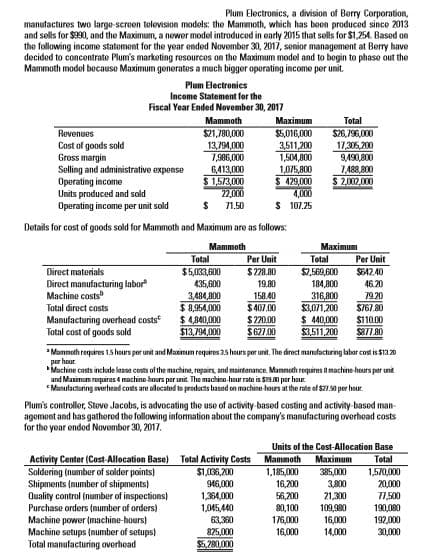Plum Electronics, a division of Berry Corporation, manufactures two large-screen television models: the Mammoth, which has been produced since 2013 and sells for $990, and the Maximum, a newer model introduced in early 2015 that sells for $1,254. Based on the following income statement for the year ended November 30, 2017, senior management at Berry have decided to concentrate Plum's marketing resources on the Maximum model and to begin to phase out the Mammoth model because Maximum generates a much bigger operating income per unit. Plum Electronics Income Statement for the Fiscal Year Ended November 30, 2017 Mammoth Maximum Total S26,796,000 17,305,200 9,490,800 1,488,800 $ 2002.000 $21,780,000 Revenues $5,016,000 Cost of goods sold Gross margin Selling and administrative expense Operating income Units produced and sold Operating income per unit sold 13,794,000 7,986,000 3,511,200 1,504,800 1,075,800 $ 429,000 4,000 S 107.25 6,413,000 $ 1,573,000 22,000 71.50 Details for cost of goods sold for Mammoth and Maximum are as follows: Махimum Mammoth Total Per Unit Total Per Unit $7,569,600 184,800 Direct materials $5,033,600 435,600 $228.80 S4240 Direct manufacturing labor Machine costs" 19.80 46.20 3,484,800 $ 8,954,000 $ 4,840,000 $13,794,000 158.40 $407.00 316,800 $3,071,200 $ 440,000 $3,511,200 79.20 Total direct costs S767.80 $110.00 Manufacturing overhead costs Total cost of goods sold $220.00 $67.00 S877.80 * Manneth requires 1.5 haurs per unit and Maximum requires 25 hours per unit. The direct manufacturing labor cost is $13 20 per hour 'Machine costs include lease costs of the machine, rapairs, and mairtenance. Mamnoth resquires 8 machine hours per unit and Mauimum requires 4 machine hours per unit. The machine hour rate is S19.0 per haur "Manulacturing overhead costs are allocated to products based on machine hours at the rate el S21.0 per hour. Plum's controller, Steve Jacobs, is advocating the use of activity-based costing and activity-basod man- agement and has gathered the following information about the company's manufacturing overhead costs for the year ended November 30, 2017. Units of the Cost-Allocation Base Maximum Activity Center (Cost-Allocation Base) Soldering (number of solder points) Shipments (number of shipments) Quality control (number of inspections) Purchase orders (number of orders) Machine power (machine-hours) Machine setups (number of setups) Total manufacturing overhead Total Activity Costs Mammoth Total $1,036,200 946,000 1,364,000 1,045,440 63,360 1,185,000 16,200 56,200 80,100 176,000 16,000 385,000 3,800 21,300 109,980 16,000 14,000 1,570,000 20,000 71,500 190,080 192,000 30,000 825,000 $5.280,000
After completing his analysis, Jacobs shows the results to Charles Clark, the Plum division president. Clark does not like what he sees. “If you show headquarters this analysis, they are going to ask us to phase out the Maximum line, which we have just introduced. This whole costing stuff has been a major problem for us. First Mammoth was not profitable and now Maximum. “Looking at the ABC analysis, I see two problems. First, we do many more activities than the ones you have listed. If you had included all activities, maybe your conclusions would be different. Second, you used number of setups and number of inspections as allocation bases. The numbers would be different had you used setup-hours and inspection-hours instead. I know that measurement problems precluded you from using these other cost-allocation bases, but I believe you ought to make some adjustments to our current numbers to compensate for these issues. I know you can do better. We can’t afford to phase out either product.” Jacobs knows that his numbers are fairly accurate. As a quick check, he calculates the profitability of Maximum and Mammoth using more and different allocation bases. The set of activities and activity rates he had used results in numbers that closely approximate those based on more detailed analyses. He is confident that headquarters, knowing that Maximum was introduced only recently, will not ask Plum to phase it out. He is also aware that a sizable portion of Clark’s bonus is based on division revenues. Phasing out either product would adversely affect his bonus. Still, he feels some pressure from Clark to do something.
Q. Comment on Clark’s concerns about the accuracy and limitations of ABC.

Trending now
This is a popular solution!
Step by step
Solved in 2 steps with 2 images




